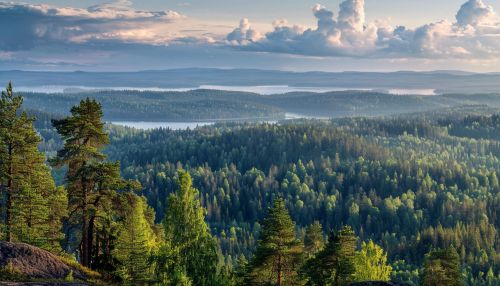Finland
Geography
Finland, officially known as the Republic of Finland, is a Nordic country located in Northern Europe. It shares land borders with Sweden to the west, Norway to the north, and Russia to the east. The Baltic Sea lies to the south of Finland, with the Gulf of Bothnia separating the country from Sweden and the Gulf of Finland separating it from Estonia.


Finland is the eighth largest country in Europe in terms of area, covering approximately 338,455 square kilometers. The country's landscape is characterized by its flatness, with more than 70% of it being covered by thick forest. Finland is also known as "the land of a thousand lakes," due to the presence of approximately 188,000 lakes.
Climate
The climate in Finland varies considerably due to its vast geographical expanse. The country experiences a boreal climate, also known as a subarctic or taiga climate. The winters are long and cold, with average temperatures often dropping below freezing. The summers, on the other hand, are relatively short but warm, with temperatures often exceeding 20 degrees Celsius.
History
Finland's history dates back to the end of the last Ice Age, around 9000 BC, when the area was first inhabited by people following the retreating ice masses. The early inhabitants were primarily hunters and gatherers, living off the abundant fish and game in the region.
The Swedish period of Finland began in the 12th century when Sweden started to extend its influence into the region. This period lasted until 1809, when Finland was ceded to Russia following the Finnish War. The Russian period, also known as the Grand Duchy of Finland, lasted until 1917, when Finland declared its independence amidst the chaos of the Russian Revolution.
Finland's independence was followed by a civil war, World War II, and a period of rapid industrialization and urbanization in the latter half of the 20th century.
Economy
Finland has a highly industrialized, mixed economy with a per capita output similar to that of other western European economies such as France, Germany, Belgium, or the UK. The largest sector of the economy is services at 72.7%, followed by manufacturing and refining at 31.4%. Primary production is at 2.9%.
Finland has significant timber, mineral (iron, chromium, copper, nickel, and gold), and freshwater resources. Forestry, paper factories, and the agricultural sector (on which taxpayers spend around 3 billion euros annually) are politically sensitive to rural residents. The Greater Helsinki area generates around a third of GDP.
Culture
Finnish culture has been influenced by the country's geographical location, with the east and west providing different influences. The culture is built upon the relatively ascetic environmental realities and traditional livelihoods, which are reflected in traditional Finnish design, such as the sauna and log cabin.
Finnish music has various genres, with folk music and classical music being the most popular. Finland also has a notable history in rock music, particularly in the genre of heavy metal.
Education
Finland's education system is renowned worldwide for its high standards and commitment to equality. The country consistently ranks high in international comparisons of national performance, such as the Programme for International Student Assessment (PISA).
Education in Finland is free and compulsory between the ages of 6 and 16. After lower secondary school, graduates may either enter the workforce directly, or apply to trade schools or gymnasiums (upper secondary schools). Trade school offers vocational education, while the gymnasium prepares students for higher education.
